#1840's costume
Text
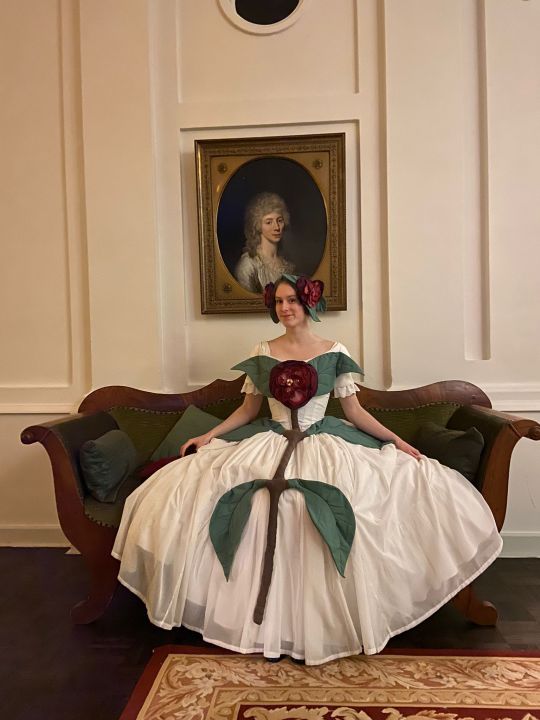


I made an 1840's style flower costume and wore it to a Victorian fancy dress ball. The design is pretty much literally taken over from this fashion plate, although I omitted the flowery sleeves (because of poor time management) and the 'necklace' (because I don't like the look of it). I'm so pleased with how it turned out. I planned to make the undergarments months in advance, but struggled so much with the corded petticoat and the corset (still didn't get it quite right in the end, but you can't really tell under the dress), that I only had six weeks to make the dress. I finished it the night before the event, as one does.
If it looks a bit frumpy in these pictures: well, I had to squeeze this dress into a tiny car first and then did some dancing before taking pictures... Still won second best place in the 'best dressed' competition that night :D
#victorian fancy dress#1840's fashion#1840's costume#costuming#historical costuming#historical sewing
41 notes
·
View notes
Photo

Spitalfields brocade dress (American, circa 1840).
Silk brocade and silk satin with cotton lining.
Image and text information courtesy MFA Boston.
382 notes
·
View notes
Text
Lady terror costume breakdown + nearly 30 hours in bernadette banner youtube history logged in the past week + finding this silky skirt in this second hand shop that fit me and then looked very 1840’s evening dress when I added a petticoat to it = miserable wretch of a human being making plans to create an 1840’s evening gown bodice to match the skirt that is way out of her skill level but needs to be done now because OC vibes…
#and I should be shot for this#hate this. HATE THIS#but we’re going to look at black lace trim tomorrow anyway bc fuck it we ball#to be clear IF this happened it’d be a ways off bc I got way too much shit going on rn to do that#but I have DREAMS#also. should I make a squeakwel to the lady terror fit post to go in depth about landlubber daywear and eveningwear????#weirdly I feel like I need to do that now#I’ve been sucked into historical costume rabbit hole and I cannot get up y’all. help
9 notes
·
View notes
Text
Eighteen-Forties Friday: A Wiener Scene
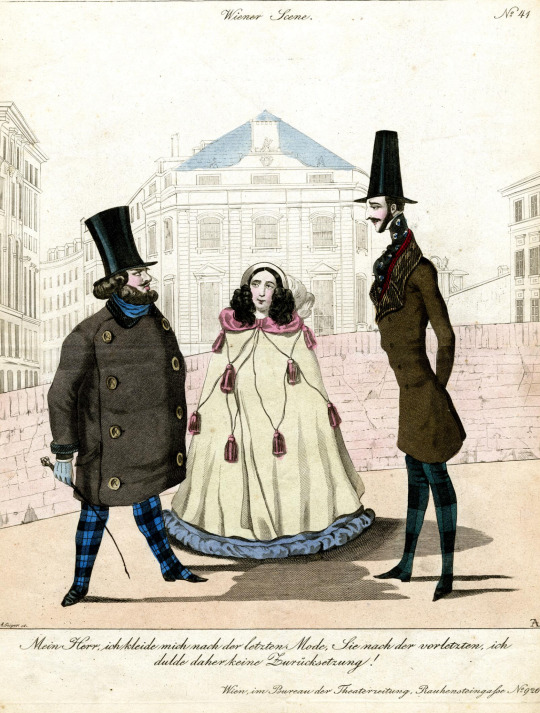
First of all, I didn't make up the title of this print (which you can clearly see); and secondly, what else does one call a scene taking place in Wien, the beautiful city of Vienna?
Two ridiculous 1840s men arguing about who is wearing the latest fashions: very on-brand for this blog. Both of them have loudly striped trousers (staring trousers as Albert Smith would say), scarf neckties, and brown overcoats. Chesterfields, Taglionis, Codringtons, Top Frocks, Paletots, English Wraps, who even knows! Even the same named style of coat could have many different forms.
The tall gentleman with his hat tapering to a narrow crown has a style of hat like what 1830's The Whole Art of Dress! calls "The Turf," and I have only noticed this style in 1830s fashion plates (more examples: one, two, three). Handbook of English Costume in the 19th Century also describes the fashionable man's top hat of the 1840s as having "the crown tending to curve out very slightly towards the top but not as markedly as in the 1820's."
So in other words, Mr. Short on the left is wearing the latest fashions, not Mr. Tall. The short man's huge coat buttons are also the trendy look mocked by The Natural History of the Gent (published 1847, one year after this print).
Women's dress is not my forte so I don't really know what to make of the huge birthday cake standing between the two men, but my best guess is that she might be wearing a burnous?
#Eighteen-Forties Friday#1840s#fashion history#dress history#victorian#fashion#caricature#early victorian era#1846#men's fashion#historical men's fashion#burnous#maybe#albert smith
87 notes
·
View notes
Text
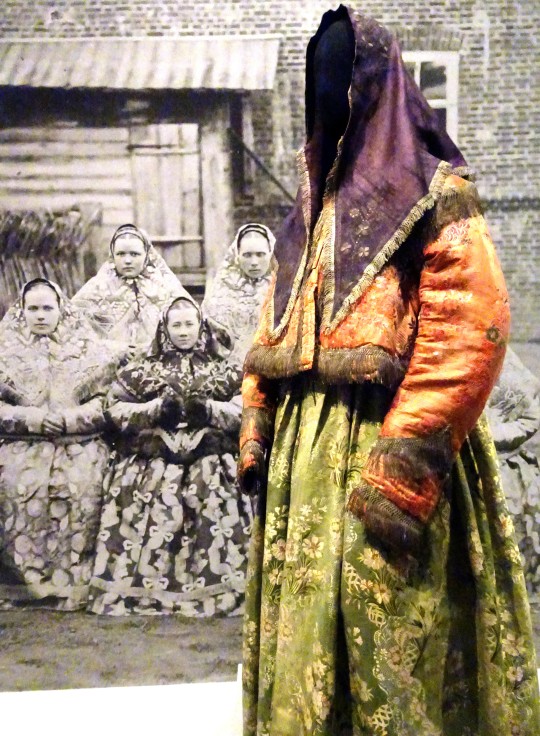
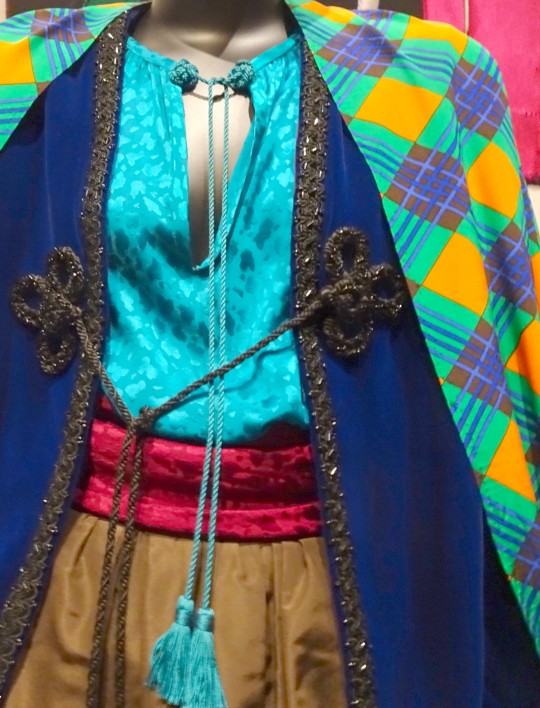





Marseille. Au MuCEM, une très intéressante expo : "Fashion-Folklore".Le titre parle de lui-même.
costume de bourgeoise mariée - Nijni- Novgorod, 1840
Yves Saint-Laurent - ensemble de soir 1976
manteau de femme riche - Saint-Petersbourg, mi-XIXe s.
idem + Yves St-Laurent - ensemble de soir 1976
les mêmes
Chanel - coiffe pour "Paris-Moscou" 2008
kokochniks - Vladimir (G) et Kostroma (D), fin XIXe s.
#marseille#MuCEM#expo#mode#fashion folklore#folklore#russie#nijni-novgorod#kostroma#vladimir#chanel#yves saint-laurent#ysl#saint-petersbourg#kokochnik#fashion
7 notes
·
View notes
Photo
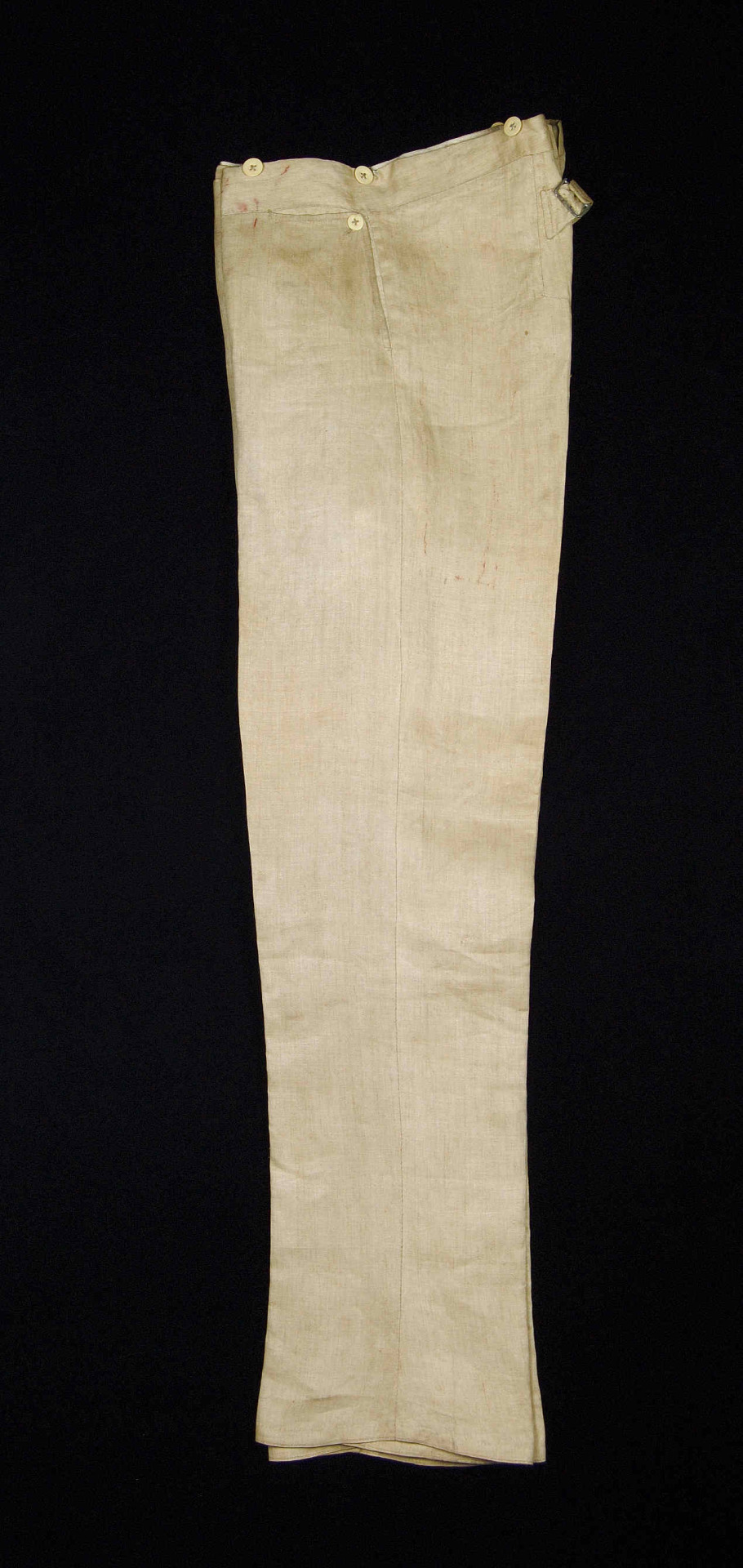
Trousers. 1840–49. Credit line: Brooklyn Museum Costume Collection at The Metropolitan Museum of Art, Gift of the Brooklyn Museum, 2009; Dick S. Ramsay Fund, 1956 https://www.metmuseum.org/art/collection/search/173970
#aesthetic#art#abstract art#art museum#art history#The Metropolitan Museum of Art#museum#museum photography#museum aesthetic#dark academia
15 notes
·
View notes
Text
I used to live in a relatively small town about 100 miles southwest of Kansas City. Not much in it other than a university and some really good Mexican food. I was at their very first pride parade. It was June, and it was hot. In Kansas, the weather is extreme. This isn’t just a climate change thing, they noticed it in the 1840’s. New England Emigrant Aid Company settlers can tell you how nonsensically cold it gets in the winter and how hot it gets in the summer. Well, it was summer when I was at the pride parade, and people could feel it. Everybody sweaty and dancing and baking in the sun. And nobody had any bottled water. Except for my priest. He sat out their in his black shirt and white color, just handing out water. People were skeptical. Rightfully so. Christianity has a history of fucking over minorities, both personally and massively. But my priest sat outside his church with a cooler full of water and rainbow stickers and his suv blasting “born this way” on loop. And people came. And he went out into the parade with his daughter in a float for her school gsa. And a guy wore a devil costume with a sign that said “Satan loves Westboro Baptist Church”. And it was good.
2 notes
·
View notes
Text
THE ROARING 20'S
The 1920's were a decade of luxury and indulgence for many; however, there was a lot more to it than just wall street and flapper dresses.
FASHION OF THE 20'S
Fashion in the 20's consisted of a lot of things. The main fashion statement of the 20's was the liberation of the corset, a very different thing from the past hundreds of years. As women were now starting to gain more rights thanks to the suffrage movement, many women did not want to be limited by the rigid corsetry of the Victorian era.
Following the movement of more fredom of clothes in the 1920s, the sillouhette generally moved away from the hourglass steriotypical. Up until this point in history, many people now prefer a dropped wait line due to its versatility to different body shapes as it made everyone look great, as well as a shorter hem. This also allowed much more freedom for movement as women found they could now dance more freely as well as play many more sports. however just because these dresses were simple it does not mean they wasn't beautiful many techniques were used to create different effects which look absolutely gorgeous
Headware and hair also changed dramatically in the 1920s. Many people opted to wear hats such as chloche hats and bobbed hairstyles. This, I believe, came mostly from the insporation of La Garconne, the bachelorette, who went against almost all society standards of the previous era, getting pregnant out of wedlock, cutting her hair short, and wearing stereotypically manly clothes.
on this website it lists many other fashion trends of the 1920s in more depth.
youtube
Also in this video is shown some of the main fashion trends with more visually shown element's.
SUFFERAGETTES
The suffering movement started in 1840 and ended in 1920, but it really picked up the pace in the early 1900s. The suffrage movement was a movement by women for women focusing on gaining more rights, in particular the right to vote.
A lot of traction for the women's rights movement came from WWI. This was because many women didn't have roles in the workplace, such as factories, etc., so when all the men were away at work, the women were needed to help run things back home while the men were at home. So when the war came to an end, many women decided that they didn't want to go back to their old lives where they depended on their husbands and, in fact, wanted to build a life for themselves and gain independence.
One of the most famous suffrage protests was at the 1913 Epsom Derby. On this day, while the horses were racing, Emily Davison threw herself in front of King George's horse, Ammer. It is unclear whether Emily intended for the horse to hit her or for the horse to stop in another part of gaining attention for the rights, but either way, this was a tragic day and made many more people fight for women's rights, and women took a lot more seriously due to the public seeing the places they are willing to go to to get their rights.
youtube
In this video it shows the tragedy of which happened to suffragette Emily Davidson
youtube
this is another video which describes the acts of the suffragettes.
HARVARD REFERENCE
BBC News. (2018). Suffragettes: 100 years since women won the right to vote - BBC News. [Online]. YouTube. Last Updated: 6th February. Available at: https://www.youtube.com/watch?v=Zbdskuuocpg [Accessed 11 March 2024].
The Guardian. (2013). Suffragette Emily Davison knocked down by King's horse at Epsom. [Online]. YouTube. Last Updated: 4th june. Available at: https://www.youtube.com/watch?v=8qkU_imbFoE [Accessed 11 March 2024].
Glamourdaze. (2020). Roaring 1920's Fashion Trends - What Did Women Wear. [Online]. YouTube. Last Updated: 1st May. Available at: https://www.youtube.com/watch?v=3hwxFc2rLIs&t=1s [Accessed 11 March 2024].
Vintage Dancer. (2019). 1920s Fashion & Women’s Clothing Trends. [Online]. Vintage Dancer. Last Updated: 25th june. Available at: https://vintagedancer.com/1920s/1920s-womens-fashion/ [Accessed 11 March 2024].
0 notes
Text
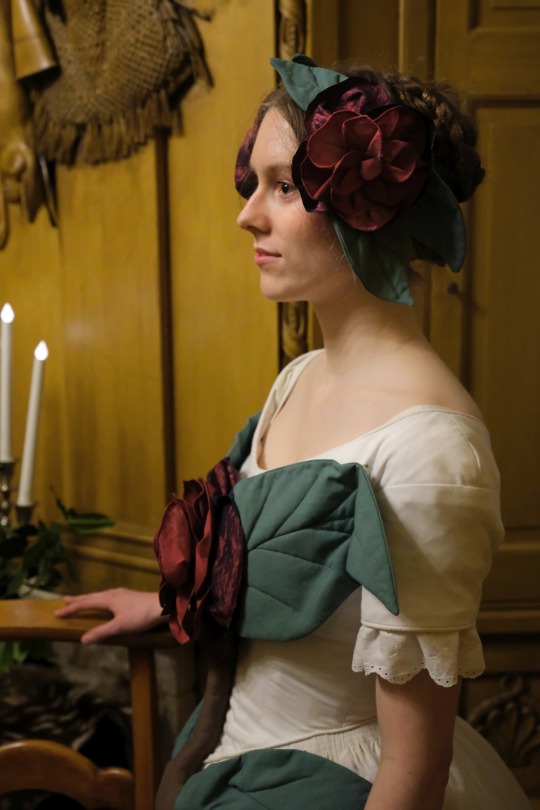
A closer look at the flower headpiece. I didn't mean to while making this, but it turned out very christmas appropriate.
Picture by Martijn van Huffelen.
#victorian fancy dress#1840's fashion#1840's costume#costuming#historical costuming#historical sewing#flower costume
5 notes
·
View notes
Text
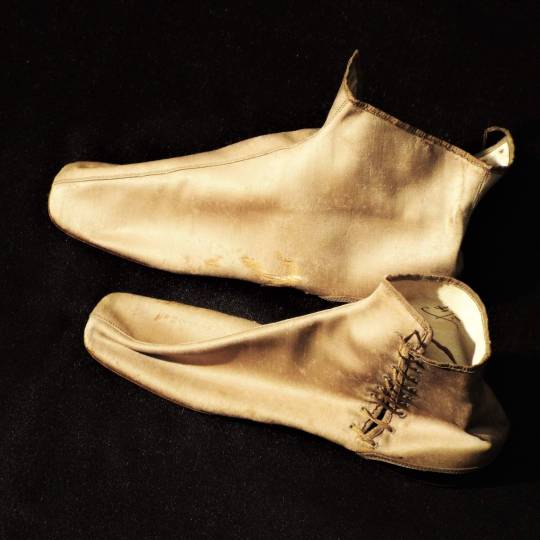
"Side lacing silk ankle boots. Black was favoured to make the foot look smaller, ivory for weddings. Elastic-sided boots appeared in the later 1830's. Very narrow by modern standards".

"White Organza Evening Dress, decorate, short sleeves, piping and neck tie to match the appliqué to the flounce skirt. Still quite light and romantic in concept. c. 1840's".
A selection from Parading Heritage Costume (No.1) > Yesterday's Fashion > Vintage Fashion uncovered
0 notes
Photo
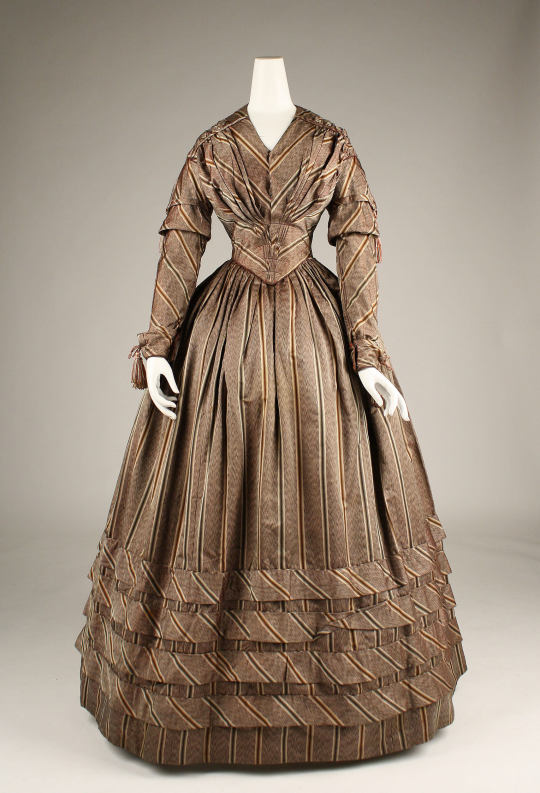


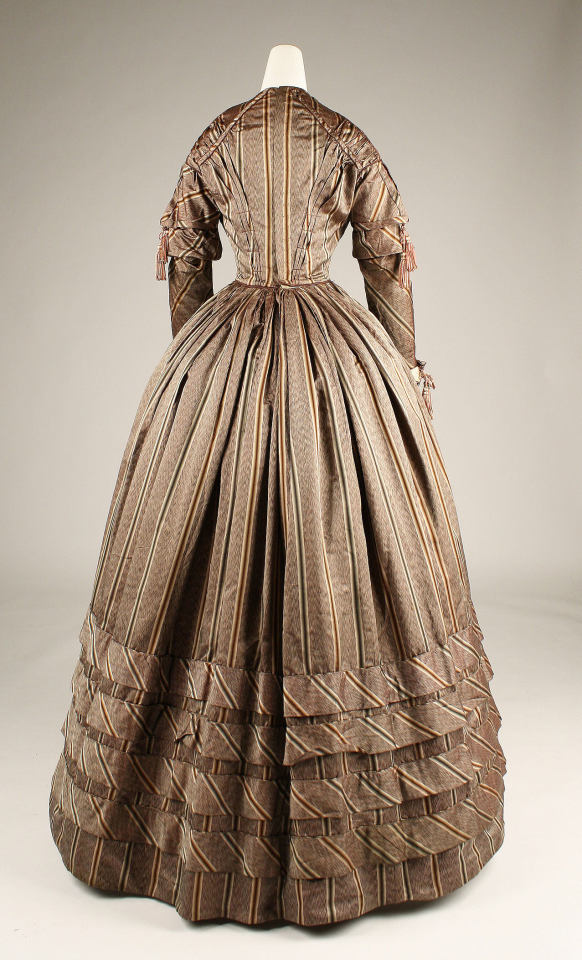
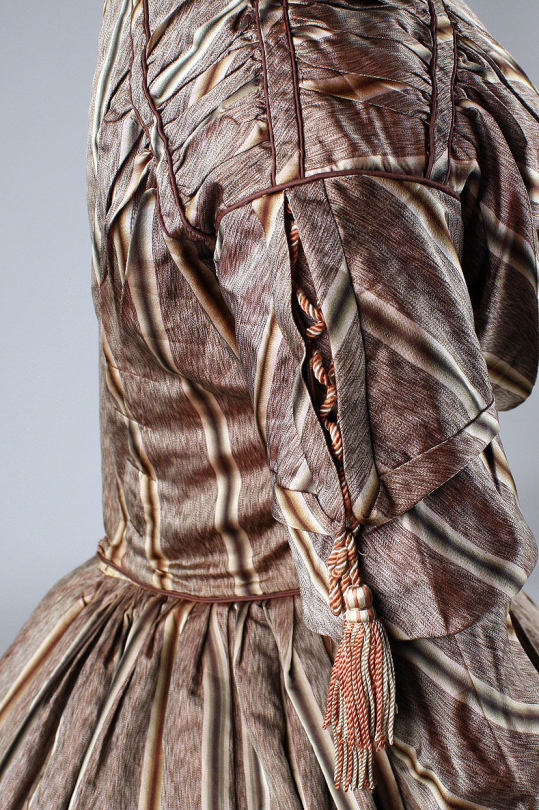


Silk dress (American, circa 1841).
Images and text information courtesy The Met.
94 notes
·
View notes
Photo

From La Mode, April 1843
#La Mode#1843#1840's#19th Century#victorian#riding habit#fashion plate#fashion plates#historic fashion#costume history#historical dress
180 notes
·
View notes
Text
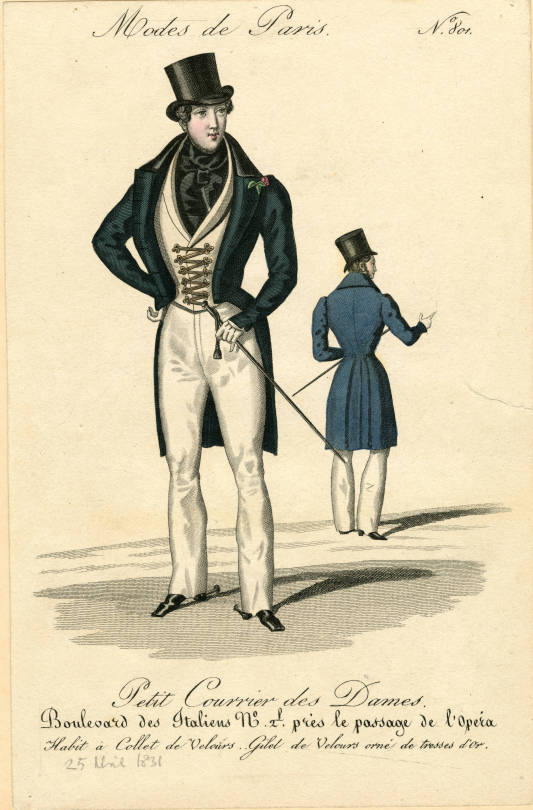
In Handbook of English Costume in the 19th Century, C. Willett and Phillis Cunnington write, "An extra hole [in men's coats] specifically cut for holding a flower in the top of the left lapel began to be made in the 1840's, though it was then more usual to use the uppermost 'button-hole' for this purpose. By 1865 the flower-hole was very common."
This fashion-forward gentleman of 1831 is ahead of the curve, using the top button-hole of his lapel for a rose:
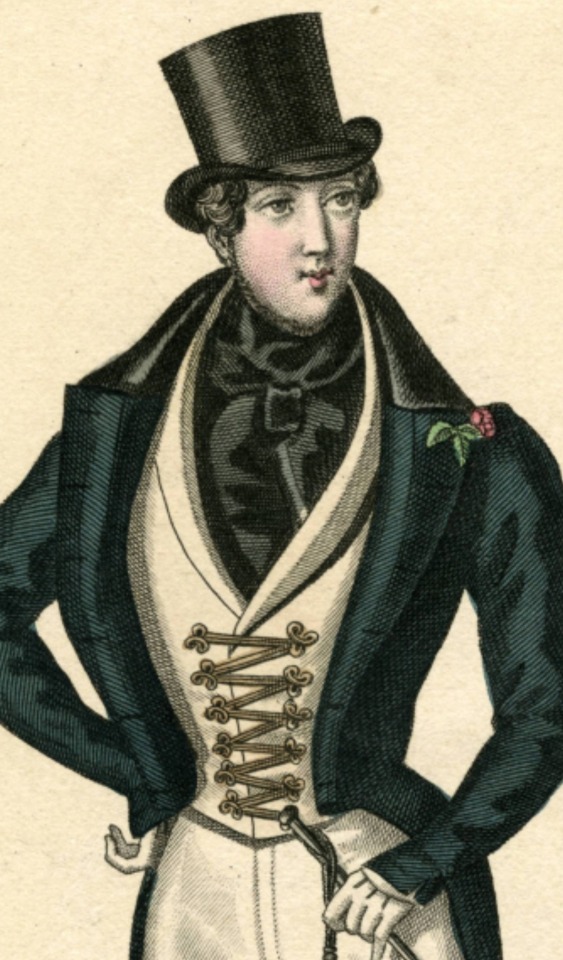
#1830s#men's fashion#fashion history#flower hole#fashion plate#historical men's fashion#Eighteen-Thirties Thursday#dress history#fashion
71 notes
·
View notes
Photo
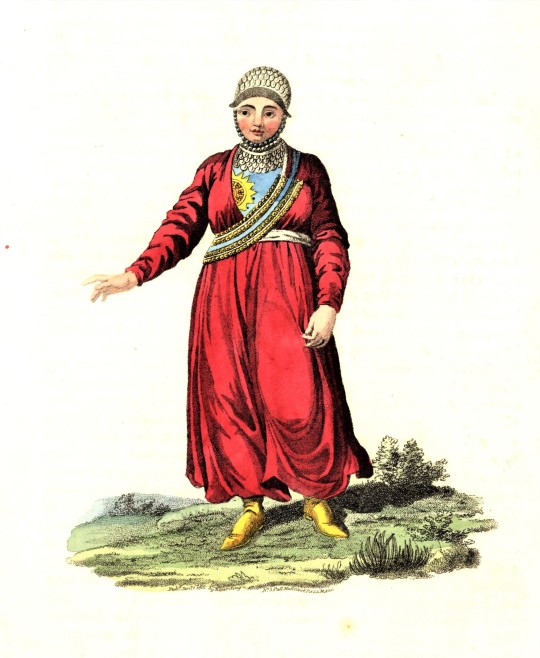

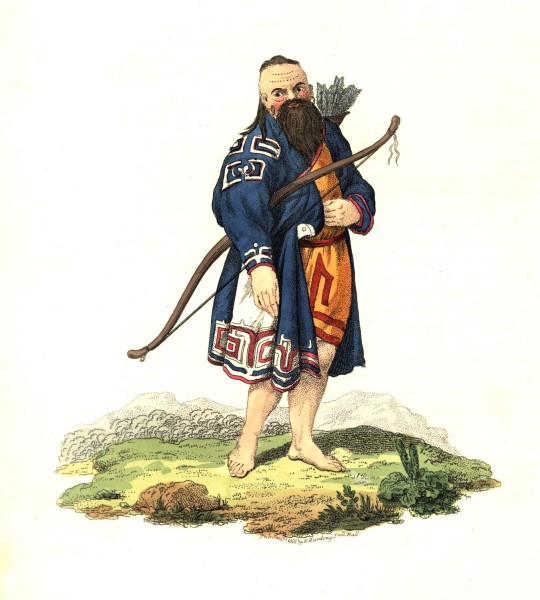
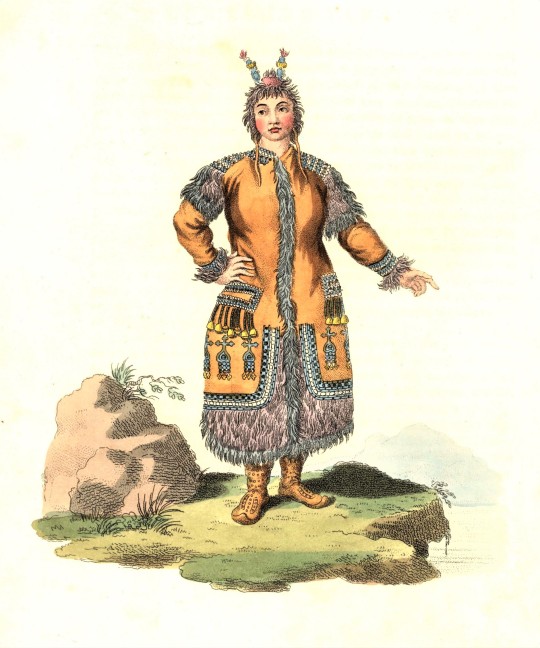
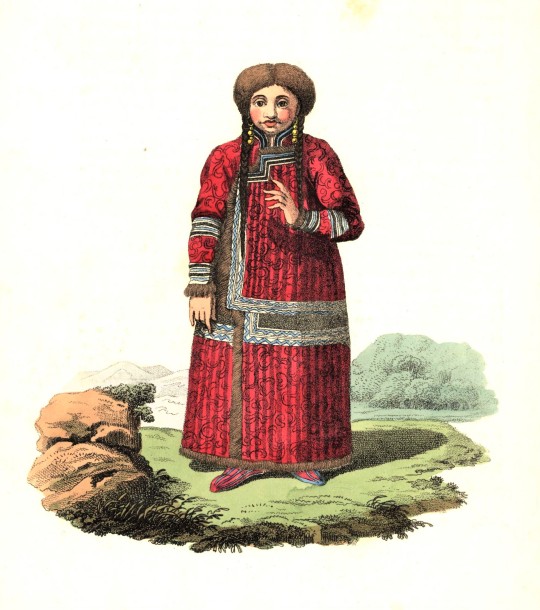
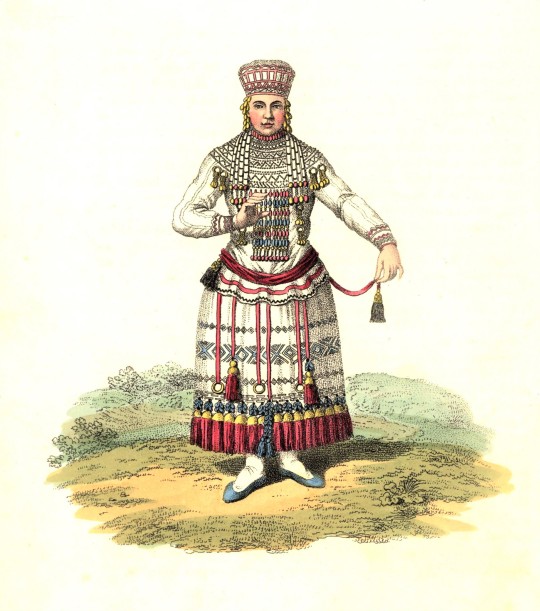

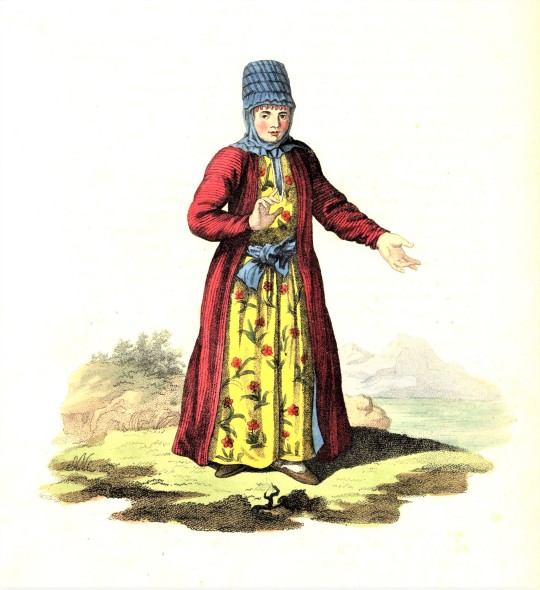
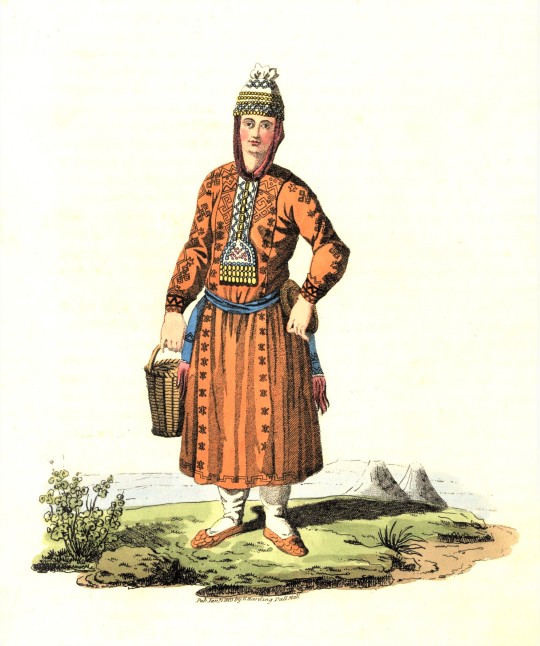

Fashion Friday - Russian Style
Today we have some vibrant plates from the 1811 edition of Edward Harding’s Costume of the Russian Empire printed by Thomas Bensley for John Stockdale. This work appears to be one of two competing publications of the same name, both first appearing in London in 1803, with texts in English and French. Both works copy the same plates and draw from the same textual source material (chiefly Gerhard Friedrich Müller, Peter Pallas, and William Coxe) as an earlier German work by Johann Gottleib Georgi, published in St. Petersburg by Carl Wilhelm Müller in the latter half of the 1770’s. The introduction to our text acknowledges the existence of this competing volume, saying “without deprecating the merit of other performances of a similar nature, the Publisher flatters himself that it will be found the most compete work of the kind that has hitherto appeared in this or in any country,” indicating the enduring quality of the “no offence, but … (full offence)” statement.
Edward Harding (1755-1840), the humble individual quoted above, was responsible for gathering the text descriptions and was publisher of the 71 hand-colored plates. Harding, at the time of the initial 1803 publication, had just been appointed librarian to Queen Charlotte, and was responsible for operating her private press. Our 1811 edition appears to be a second printing of a 1810 second edition, with descriptions expanded from the first edition, though it is unclear if the dedication to Charlotte’s daughter, Princess Elizabeth, was present in earlier editions. Perhaps someone out there with a 1803 or 1810 pressing can weigh in!
The text was printed by Thomas Bensley, a collaborator of Friedrich Koenig, inventor of the high-speed steam-powered printing press, and Bensley himself made innovations in adapting steam-powered printing to book publication, as well as advancements in lithography. Bensely was considered by many to be one of the finest printers working in London in his day, with William Bulmer his main rival. This edition is published by John Stockdale, who incidentally published the other English/French Costume of the Russian Empire (with text by William Alexander and a different arrangement of the same plates) concurrently with the Harding edition. Bensley did the printing for both. I can find no comment on their opinions of which is the superior publication.
Harding writes, “the people of such extensive regions, stretching over a considerable part not only of Europe, but of Asia, exhibit a singular diversity in their Manners, Customs, and Dress.” The volume collects “their most striking Costumes.” Presented here, in order, are:
1. A Female Tartan of Kazan
2. A Female Ostiak
3. A Kurilian
4. A Female Yakut
5. A Katschintzian Tartar Woman
6. A Mordvin Woman of the Mokchanien Tribe
7. A Tongusian, in his Usual Dress
8. A Female Kirghis.
9. A Tschouvachian Woman
10. A Woman of Finland in her Holiday Dress
I’m particularly fond of the head gear on the Tartan of Kazan and its evocation of chain mail partnered with the elegant draping of her red dress (or is it a wide-legged trouser?).
Check out our past Fashion Friday posts.
-Olivia, Special Collections Graduate Intern
#fashion friday#russian fashion#Costume of the Russian Empire#Edward Harding#Thomas Bensley#John Stockdale#handpainted plates#handpainted prints#olivia
123 notes
·
View notes
Text
Notes on Visions’ costumes
Kara (The Ninth Jedi): cannot for the life of me decide if Kara’s hoodie classify as a kimono. The shortened length puts it in Haori but it doesn’t have a straight collar. Also it’s serving more as a main piece instead of a jacket over the kimono. And the fact that it is properly closed with possibly a Hanhaba Obi if not something even simple with the lack of a visible knot. The sleeve length is common though sleeve hole is not small so I can’t put it in Kosode despite the straight slanted collar. So in the end it’s really more a hoodie jacket with overlapping collars and kimono sleeves? I did consider if I could call her whole ensemble a Jinbei but there’s the Obi and she is wearing it as a formal representation of herself. Yeah, so it’s more a kimono-inspired design but the sleeves, belt and Tasuki cord has all the most recognizable elements.
F (The Village Bride): Naturally all the kimono-wearing ladies has a modern/fantasy twist to it. Out of the bunch F’s ensemble might be closest to tradition, but it was still paired up with high heels instead of ankle boots. This point was particularly noted on during the special programme by director Hitoshi Haga as he mentioned the crew brought in heels to try the look on. Another deviation is that her single-layer collar is open quite wide over a turtle-neck, plus the sleeves are cut much shorter than the usual combo of furisode and the belt area is simplified. So you’d call her look 和洋折衷/Japanese-Western fusion (term applicable not only to fashion).
Haru (The Village Bride): The silhouette of Haru's bridal costume is closer to a 1840-50 evening dress with an off-shoulder neckline and poofy skirt. Though white only became western bridal standard after Queen Victoria's example, it has been a symbol of purity and choice of wear in rites of passage since the 15th century in Japan. The complementing blue recalls the craft of indigo-dyeing, under the spotlight courtesy of Tokyo 2020's designated colour. Despite a classic bridal/princess dress, Haru's horn headdress could be a smart subversion to the traditional Japanese bride's Tsunokakushi hat. 角隠し literally means "hiding the horns", as a metaphor to remind the bride to hide her temper and to become an obedient wife. It is the opposite case with Haru, where her love gave her courage to face the bandits.
Ocho (Lop and Ocho): I was a bit confused at Ocho’s childhood look at first because her ensemble is the standard festive costume for three-year-old girls at Shichi-go-san. I suppose it lends to the character’s innocence? The red-mustard-turquoise palette is a bit garish at first but the components from head-to-toe is actually quite typical: A (tsumami/fabric flower) kanzashi/hairpin, contrast lining or juban, hifu/poncho with the same hinata kamon/three-dots-in-a-circle family crest as her father and a pair of tabi/socks and funegata geta/wooden flip flops. Even the crest placement is faithful. Oh— the white chrysanthemum wouldn't be out of place if it was her mother that just died…
Ocho’s grown-up look is dramatic, over-the-top, perfect. The palette is the same except a darker shade in navy blue replaced turquoise. The gigantic bow reminds me, besides her namesake/kanji ‘butterfly’, of kabuki actors. I found the character Genkuro wearing a similarly exaggerated tasuki and side-slit kimono. While the character doesn’t share much in common, its play Yoshitsune Senbon Zakura, bears a similar backdrop of sakura blossom season and sibling rivalry. In kabuki makeup called kumadori, red is hero and blue is villain. In the mean time, scarlet eye makeup for geisha ‘wards off evil’ (along with the practical effect of making one look more spirited). I am fascinated by the conjecture that while Ocho’s costume is hinting at her antagonistic role, the dramatic blood eyeliner signifies Ocho’s mindset in seeing herself as the hero of the story. Then there’s the usual colour symbolism (or lack thereof) of stripping one’s identity with plain white armour/uniform. The cherry blossom + river motif is fairly normal. Before I noticed the Kabuki connection, I thought the side-high-slits were perhaps inspired by cheongsam and anyway is an act of rebellion against tradition by cutting up the furisode (thank goodness the sleeves are visibly longer than Kara’s). Either way, that’s a really cool look for a crime boss with the thigh-high boots and tattoo sleeves.
#yeah this for now#The Duel gets it own post. if.#star wars visions#The Ninth Jedi#The Village Bride#Lop and Ocho#my sw meta#sw visions#star wars
98 notes
·
View notes
Photo
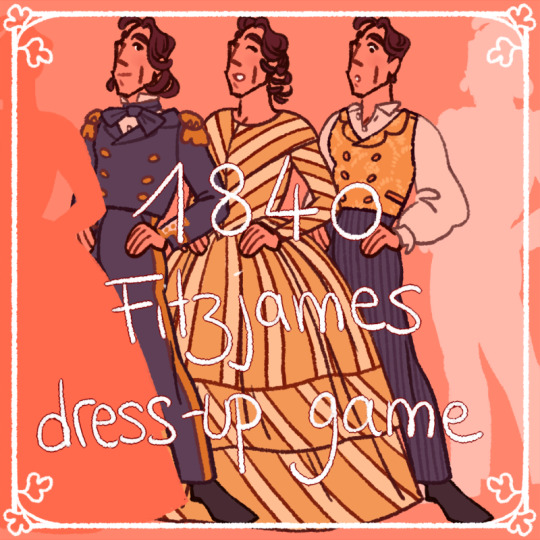
it’s here ! Not 100% historically accurate at all but i hope it won’t keep you from having fun !
some resources I used below the cut.
The Fashion History Timeline’s article on the 1840s, The Met’s collection of fashion plates (so many), a few men fashion plates on victoriana.com, pictures from OSF Costume Rentals (thank you @fritzllang), The Terror (2018), Poldark (2015) & Dickinson (2019) gifsets ^^
#the terror*#picrew*#james fitzjames#no hats yet but I DID put in the Brittania costume#& no man corset bc i wouldn't find how they looked in the 1840s :.o
242 notes
·
View notes